An Amazing Comeback: Co-Existing with Beavers
July 26, 2023
By Erin Parker, Interpretive Services Supervisor
In 2008, when beavers first showed back up in the Detroit River near the Conner Creek Power Plant, after 75 years of absence from the River, people had a lot of reason to celebrate. Beavers need habitats that provide plenty of their favorite foods like cottonwood and willow, they need clean water to keep their waterproof fur free of oils and other pollutants, and they need quiet areas where they can rear their young. For many years, the Detroit and Rouge Rivers, among others, couldn’t offer all of those things. It took a lot of effort to clean up pollutants, remove barriers and trash in the rivers, and allow trees and other vegetation to grow. The return of animals like beaver, osprey, and recently, river otters, to our once-highly polluted rivers and streams are success stories that tell us a lot about the restored health of these ecosystems. Now, with beaver populations doing well throughout southeast Michigan, we need to re-learn to coexist with them and their not-always-appreciated habits!
Beavers in the landscape
Beavers are rodents, which means they have constantly-growing ‘gnawing’ incisors that they utilize to reach their favorite foods- the young buds and bark on the tops of deciduous trees. Because they don’t climb, they’ve evolved with an amazing strategy that manages those teeth and nets them leafy meals. Beavers use their strong jaws and large incisors to fell trees where they can then access the tasty top-most parts! They even consume these leafy tips during the winter by “planting” a beaver garden of summer cuttings in the sediments around their lodges so that they have access to food all winter long! The harder, less-tasty remains of the inner wood becomes material for lodge and dam building once spring warmth opens up their watery homes from ice-cover. Beavers don’t hibernate, so they ability to swim out under the ice to reach their stored food is imperative to surviving and thriving!

Winter is also the time when beavers mate, with litters born in spring…nicely timed with the flush of first leafy food growth! Beaver kits can swim within a day or two of birth, and start exploring out of their lodge soon after. It takes a lot of work to learn to be a beaver, and kits typically stay with their parents and siblings for two years. Most beaver kits leave the lodge and disperse to find their own mate and home at around two years old.
While the recovery of beavers is a wonderful environmental success story, they can and do have the potential to create headaches for homeowners and land managers. Beaver’s preferred diet sometimes overlaps with human’s favorite trees and having a beaver fell a tree (or many trees!) on a piece of property can cause a variety of potential problems and dangers.

Co-existing with beavers
Protecting beloved trees from beavers can be as simple as wrapping the lower trunk with write fencing that stretches about 4 feet high, so that even in snowy conditions, beavers can reach the bark above the fencing. Because beavers can’t chew through the metal wire, they’ll leave these trees alone.
Culverts are another favorite beaver trouble spot! The sounds of running water in a culvert seems to trigger beaver activity to stuff that culvert with material, much like they would do if they heard running water in their lodge. Beavers dam up streams (and culverts) to create flooded ponds that help protect them from predators and provide a safe shelter for their lodges. While beneficial to our ecosystems, having flooded trails, roads, and properties can be really frustrating and expensive for land owners and park and trail managers. Culvert guards and fencing can prevent beaver access to blocking up culverts. Tubes, inserted into the culvert and extending out into a body of water, can allow water to flow through the culvert while simultaneously reducing the running water sounds that beavers are drawn to ‘fixing’.
The return of beavers has a variety of benefits to our landscapes and ecosystems. Their activities provide food and shelter for a variety of aquatic insects and animals; the saturated soil that is created though the development of ponds and marshes helps filter water, store carbon, and create habitat for other wildlife. They are considered a keystone species, or a species that supports a variety of other species in an ecosystem. Named for the wedge at the top of an arch, a keystone supports everything else and the removal of that keystone impacts everything else. Beavers belong here and provide many benefits. Their return tells us a lot about the health of our local waterways and woodlands. It may take a small amount of human engineering to work with “nature’s engineers” to protect favored trees and prevent unwanted flooding, but we should be celebrating their return as an environmental success story!

